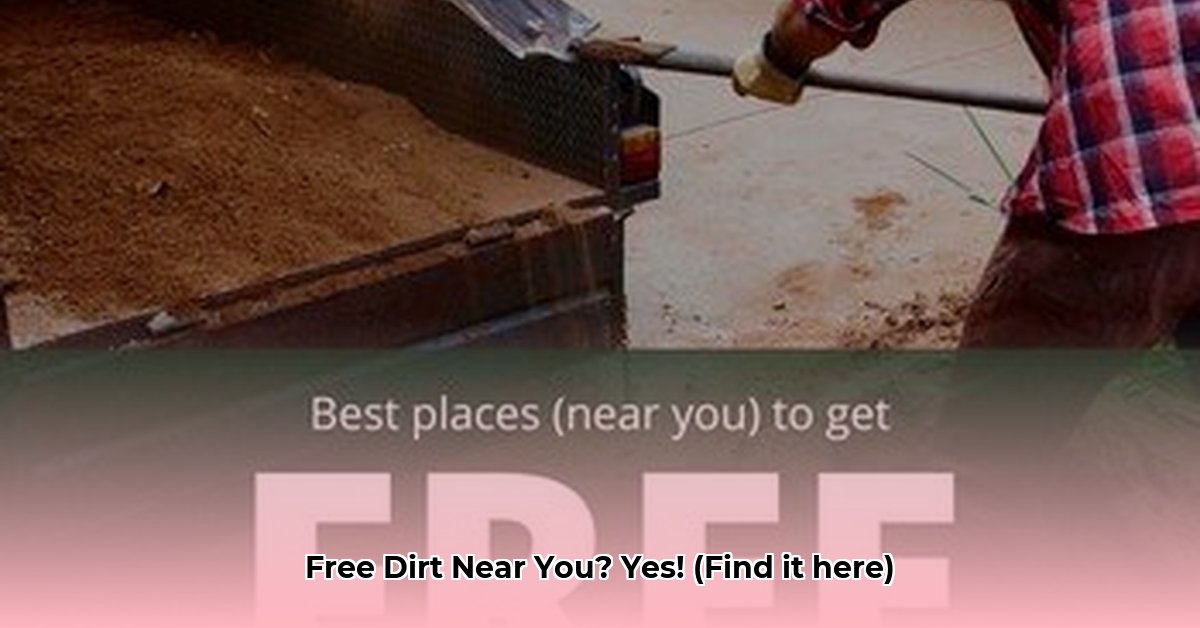Want a picture-perfect lawn or a thriving garden without emptying your wallet on fill dirt? You’re in luck! This guide reveals the secrets to finding free fill dirt in your area, helping you slash landscaping costs. We’ll explore the best local sources, show you how to ensure the dirt is safe, and guide you through transportation and legal considerations. Let’s transform your outdoor space without spending a fortune!
Unearthing Your Free Fill Dirt: A Treasure Hunt
Free fill dirt is often closer than you think. Here’s how to uncover it:
Online Marketplaces: Connecting Dirt Seekers and Suppliers
-
DirtMatch (and similar platforms): Specialized platforms like DirtMatch aim to connect those needing fill dirt with those having excess. While such dedicated services can be incredibly useful, their availability and activity vary by location. It’s always wise to check if they’re active in your area. Even if a specific dirt exchange isn’t available locally, general online marketplaces and community forums often have listings for free fill dirt. These can be valuable resources, but always proceed with caution when dealing with individuals online.
-
Craigslist: This online classifieds giant can be surprisingly helpful. Search using terms like “free fill dirt,” “free topsoil,” or “free clean fill,” adding your city or region. When contacting potential suppliers, ask detailed questions about the dirt’s origin and prior use. This will likely provide clues about its suitability for your needs.
Directly from the Source: Businesses with Excess Soil
-
Construction, Excavation, and Pool Companies: These businesses often have surplus dirt from their projects, and they’re usually happy for someone to haul it away. Locate them via Google Maps or online directories. A polite phone call or email explaining your project and needs can often yield positive results. Be ready to discuss logistics, as you might need to arrange pickup or transportation.
-
Landscaping Companies: While less common than construction companies, landscapers sometimes have leftover soil from projects. It’s worth reaching out to local landscaping companies to inquire about their soil disposal procedures.
-
Demolition Sites (Proceed with Extreme Caution): While demolition sites might seem like a plentiful source, the soil there carries higher risks of contamination. It’s generally recommended to avoid dirt from these sites to minimize potential problems.
Community and Government Resources: Untapped Potential
- Municipal Programs: Some local governments offer programs that distribute leftover soil from public works projects or community gardens. Check your city or county website or contact local government offices.
Is Your Free Dirt Safe? Quality Control 101
Free doesn’t always mean problem-free. Contaminated soil can harm plants, pollute your property, and even pose health risks. Before you haul your dirt home, take these precautions:
Inspecting Your Potential Dirt: A Step-by-Step Guide
-
Visual Inspection: Look for any signs of debris (trash, plastic, large rocks), unusual colors, or foul odors. If anything seems amiss, proceed with caution or consider another source.
-
The Smell Test: Trust your nose! Does the dirt smell earthy and natural or like chemicals? An unpleasant odor might suggest contamination.
-
Texture Check: Get your hands dirty! Is the soil clumpy clay, loose sand, or a rich, crumbly loam? The texture can tell you much about its composition and suitability for your project.
-
The Jar Test: Fill a clear jar with dirt and water, shake vigorously, and let it settle. This separates soil layers, revealing potential contaminants. An oily residue or strange particles are red flags.
-
Professional Soil Testing (Recommended for Gardens and Play Areas): If you’re using fill dirt for a vegetable garden or children’s play area, a professional soil test is crucial. It identifies potential contaminants, ensuring the safety of your plants, family, and pets.
Free vs. Paid: Weighing the True Cost
While free fill dirt is tempting, buying it sometimes makes more sense.
| Feature | Free Fill Dirt | Purchased Fill Dirt |
|---|---|---|
| Cost | Free (excluding transportation) | Varies by quantity and type |
| Quality | Variable, requires thorough inspection | Typically screened and consistent |
| Contamination | Higher risk | Lower risk |
| Convenience | Requires sourcing and transportation | Delivered, ready to use |
| Peace of Mind | Lower | Higher |
Hauling Your Dirt: Logistics and Legalities
Transportation Options: From DIY to Professional Hauling
Getting your dirt home requires planning:
- DIY: For smaller quantities, a pickup truck or trailer works well. Remember to secure the load to prevent spills.
- Rental: For larger projects, rent a dump truck or larger trailer. Factor rental costs into your budget.
- Professional Hauling: Consider a hauling service if DIY isn’t feasible. Obtain quotes from multiple providers.
Permits and Regulations: Staying Legal
Before transporting or receiving large amounts of fill dirt, check local regulations. Some areas require permits or have restrictions on soil types. Contact your local government for specific guidelines.
Sustainability and Legal Landscape: Being a Responsible Dirt Mover
Reusing excess soil is environmentally beneficial, diverting it from landfills. However, always comply with local regulations concerning its use. Regulations vary by location, concerning acceptable soil types and project size.
Ready to Transform Your Landscape?
Finding and using free fill dirt can be a rewarding way to improve your outdoor space without breaking the bank. By following these tips and taking necessary precautions, you can embark on your project armed with knowledge and confidence. Happy digging!
- Greenhouse Storage Shed Combos: Your Guide to Combining Growing and Storage - April 21, 2025
- Greenhouse Shed Combo: Design, Build & Grow Year-Round - April 21, 2025
- Gingham vs. Plaid: What’s the Difference? A Complete Guide - April 21, 2025










